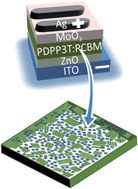Interplay of nanoscale domain purity and size on charge transport and recombination dynamics in polymer solar cells†
Abstract
Charge transport and bimolecular recombination dynamics were correlated with nanomorphology in polymer solar cells. The morphology of poly(diketopyrrolopyrrole-terthiophene) (PDPP3T) and phenyl-C61-butyric acid methyl ester (PC60BM) blend films was modified using different solvent additives namely 1-chloronaphthalene (CN), 1,8-diiodooctane (DIO) and 1,8-octanedithiol (ODT) and their role on steady state and transient optoelectronic properties was investigated. The energy filtered transmission electron microscopy (EFTEM) images showed that additives (e.g. CN and DIO) improved the domain purity which leads to significantly higher short circuit current densities (Jsc). However when the cells were processed with the ODT additive, the fill factor (FF) and open circuit voltage (Voc) decreased dramatically. Films processed with the ODT additive showed a smaller domain size but were more connected compared to films processed using CN and DIO additives. Transient photocurrent analysis indicates faster charge collection in the case of CN and DIO processed solar cells and the slowest charge collection in ODT processed solar cells. Interestingly devices processed with the ODT additive also showed the longest charge carrier recombination lifetime and lowest bimolecular recombination coefficient. This is attributed to the smaller donor domains that are connected with each other to provide a more interconnected and efficient charge transport matrix but longer pathways in ODT films. Such a matrix helped the charge to escape from the donor–acceptor interfaces and thus reduces the bimolecular recombination, while the longer pathway increases the charge collection time. Further insight is provided into the selection of processing conditions to achieve an ideal active layer morphology consisting of domains with higher polymer purity and optimal size that lead to higher Jsc and FF.


 Please wait while we load your content...
Please wait while we load your content...